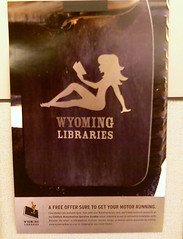In three days, I’ll be on a plane, flying to Copenhagen, Denmark. I lived there for almost a year in college and I haven’t been back in nine years. I’m speaking at a conference on Sociale teknologier i fremtidens bibliotek 2.0 (Social Software and the Future of Library 2.0) on September 27. I absolutely can’t wait to be back in Copenhagen and visit all the places I used to love.
There were a bunch of posts I really wanted to write about, but it seems like I’m not going to have time. Instead, I’ll just highlight them here.
My Story About Telling Stories
Sometimes people think that blogs have magical powers to make your library’s traditional news content more interesting and its image more human. Really, it’s just a tool. It’s the way we write that engages our users or bores them to tears. It’s our tone that makes the library seem more approachable and human. Emily Clasper wrote a terrific post about the difference between blogging matter-of-fact news information and telling a story with your blog posts. Writing engaging copy is an art and it’s critical that people don’t ignore this aspect of library blogging.
The future of Web Services isn’t the Library website
This was one of the best posts I’ve read in a long time. Karen is someone who really works on the web. Her life has revolved around her University’s web redesign for nearly two years. And she rightly understands that making the website pretty and usable is not the most important part of the redesign. Karen talks about the importance of designing content to be reused and repurposed in other places. Why is that?
Meeting your users where they are isn’t about making them come to the library website. In considering our long term virtual presence plans, the library website is a given. People who come to the site know we exist and want to use our services. To truly be successful we have to get our content into the path of the people who wouldn’t walk through our door (physical or virtual).
This is such an important point. We need to not only have a great website, but have content that can easily be put where our users’ eyes go. No matter how nice our library website is at Norwich, most students will never visit it. Something my colleague Josh and I have been thinking about is how to put our content in their path, be it with RSS feeds, putting content in social networking software, or browser toolbars. We considered LibGuides at our library, but (at $899 – $2499 annually) it’s priced to be inexpensive for large libraries and way too expensive for tiny libraries like ours. But I’ve definitely come to the conclusion that I’d rather spend my time getting our library content where our users are than focusing on creating the perfect website. Nice to see that people whom I admire so much, like Karen, feel that way too. The woman doesn’t post to her blog enough, but when she does, it’s worth the wait.
The Mudflap Girl
I saw this two days ago on my Flickr friend photostream and I thought huh, cute marketing and didn’t look at it too closely. But when I heard the story behind it, I thought it was one of the most brilliant marketing schemes I’ve heard of in a long while. Steve Johnson wrote me to explain it:
They are using a picture of a reading “mudflap girl” to advertise their new statewide ChiltonLibrary.com auto repair manual database. They are planning to put her into autopart stores all around the state to let male non-library users know about the new database.
Brilliant! Talk about going where your users are! The Wyoming Libraries campaign also has some cheeky bumper stickers and some T-shirts that even I want to buy! It’s great to see libraries doing such aggressive and clever marketing campaigns!
Offering Premium Resources
Marketers know that people like to think they’re getting something special that other people don’t have access to. They like their “premium content.” The Disruptive Library Technology Jester points out a clever way to market library databases; selling them as “premium content”:
Beyond Google Your library card is all you need to access our premium online resources! Visit our reference page to browse a list of topics and research almost anything under the sun.
I love it! If you’ve got to call your “databases” something, “premium resources” sounds pretty darn good!
Don’t have too much fun without me next week and I’ll be sure to eat some wienerbrød for you. 🙂





I thought it was brilliant, too:
http://shelfcheck.blogspot.com/2007/09/shelf-check-93.html